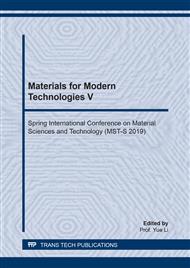[1]
YANG Shou-jie,LU Zheng,SU Bin,et al. Development of Aluminum-Lithium Alloys, Journal of Materials Engineering,2001,5:44-47.
Google Scholar
[2]
Roberto J. Rioja, John Liu. Met Mater Trans A , 2012, 43A:3325.
Google Scholar
[3]
Dimitrios Tsivoulas, Philip B. Prangnell. Met Mater Trans A , 2014, 45A:1338.
Google Scholar
[4]
Niinomi M, Kolobnev N I, Chuistov K V, Kotko A V, et al. Strengthening and toughening by microstructural control in 2091 Al-Li alloy[J], proc. Inc. int. conf. on Aluminum Ⅳ, 1994, 1:342-350.
Google Scholar
[5]
Gregson P J, Flower H M. Microstructural control of toughness in Aluminum-lithium alloy. Acta. Metall., 1985,33(3):527-537.
DOI: 10.1016/0001-6160(85)90095-1
Google Scholar
[6]
Jiang Na,Xiang Shuguang, Zheng Ziqiao. Strain-ageing process for Al-Li alloy CP276. The Chinese Journal of Nonferrous Metals, 1999, 9(4):694-699.
Google Scholar
[7]
Zhou Mingzhe, Yi Danqing, Jia Yanlin,et al. Effect of Pre-deformation on Aging Precipitation Process of 2E12 Aluminum Alloys. Rare Metals and Engineering, 2010, 39(12): 2107-2111.
Google Scholar
[8]
Tian Rongzhang, Wang Zhuang. Aluminum Alloy and Its Processing Manual. Changsha, Hunan, Central South University Press, 2000, 103~108.
Google Scholar
[9]
KANEKO J.Thermomechanical treatment of aluminum alloys. Journal of the Japan Society for Heat Treatment, 1981, 21(6):331-336.
Google Scholar
[10]
LATKOWSKI A. Properties of Al-Cu-Mg alloys after thermomechanical treatment. Aluminum, 1986, 62(2):113-115.
Google Scholar
[11]
E. Di Russo,M. Conserva, F. Gattp, H. A new thermo-mechnical procedure for improveing the ductility and toughness of Al-Zn-Mg-Cu alloys in the transverse directions.Markus..Materials Science & Engineering, 1974, 14: 23~36.
DOI: 10.1016/0025-5416(74)90120-7
Google Scholar
[12]
Rioja, R.J. Fraction methods to manufacture isotropic Al-Li alloys and products for space and aerospace applications. Mater. Sci. Eng. A257, 100-107. Transactions of Nonferrous Metals Society of China, 2013, 23: 1728-1736.
Google Scholar
[13]
Starke E. A,Lin F.S., 1982. The influence of grain structure on the ductility of the Al-Cu-Li-Mn-Cd alloy 2020. Met. Trans, 1982, 13A: 2259-2269.
DOI: 10.1007/bf02648396
Google Scholar
[14]
Jata, K.V., Stake, E.A., 1986. Fatigue crack growth and fracture toughness behaviour of an Al-Li-Cu alloy. Met. Trans.A 17A: 1011-1026.
DOI: 10.1007/bf02661267
Google Scholar
[15]
ZHANG Xianfeng, LI Guoai, LU Zheng, et al. Effect of preaged stretch after quenched on the properties and microstructer of a naturally aged al-li alloy. Acta Metallurgica Sinica,2016,52(12):1497-1502.
Google Scholar


